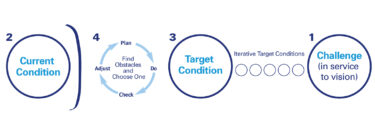You hear it in the language people use that they don’t have the deep operational knowledge of their warehouses and distribution centers to launch or sustain a lean transformation. For example, a few of my favorite expressions are:
We got slammed today.
I got a grip of work.
A full dock is a happy dock.
When you ask people what these statements mean, they can’t explain clearly, aside from saying that they felt like they had had too much work, an adequate level of work, or wouldn’t run out of work soon.
But to transition successfully to a lean distribution environment, operations should first have certain essential information about their business. This includes solid and thorough data about demand, costs and productivity, customer satisfaction, and storage. Nine times out of 10, in my experience, they don’t. So the lean transformation stalls when an important fact isn’t known because management felt that finding out was unnecessary or required too much effort or time.
False Data
One area that’s often problematic is variability in daily performance reporting. Some operations flat-out don’t have it, others have it but at a very high level, others have it but the data is corrupt, others have it but there is variation in how the hours are recorded across the operation.
One facility I worked with said it had daily performance reporting, but admitted it completed it just to comply with HQ requirements. It was an open secret that it was falsified to meet company-set targets.
On a different occasion, I asked the operational management four times if the information on the reports were valid. Each time they told me yes. It wasn’t until we were using it to set baseline numbers and targets for improvement that they finally had to ‘fess up that they were overstating productivity. If we had used that information as their baselines, they would never be able to meet targeted improvements. We had to clean up the reporting to know what our current state really was. Then, we had to notify HQ of the discrepancies, which resulted in lost time and a lot of unpleasantness. Needless to say, the local management did not find me endearing. (Read Dave’s related article about the cultural and behavior changes needed for a successful lean transformation:For Distribution Managers, Lean Means a Sea Change in Roles)
Because what I call “Knowing Your Business” (KYB) requires a greater breadth and depth of information than most operations tracked in the past, there are no processes or infrastructure in place to get the information. It’s like building a road while driving on it. Data sampling, ad hoc queries coupled with more manual data collection and analysis, provides a temporary fix. However in the long run the infrastructure needs to be built to gather the information you need to truly know your business.
The primary objectives of “Knowing Your Business” are:
- Understand the current state; cost, quality, and delivery baselines
- Set improvement targets
- Redesign processes
- Identify quick wins and improvement opportunities.
For demand data, the information you need to know about the business typically includes three primary categories: outbound operations, inbound operations and storage.
Demand
Many operations do not have basic outbound or inbound demand information readily available at an appropriate level of detail or in a usable format for data analysis. Having this information and the right level of detail is essential for a good lean implementation. The amount of historical information needed will depend on:
- Your type of business
- Management’s knowledge of the current business
- Implementation expectations and approach of the lean transformation (small, fast, and experimental vs. broad, integrated, and with hard launch expectations)
- Time and resources constraints
- Level of risk an operation is comfortable with at launch.
Demand data collection and analysis typically covers no more than twelve months of historical information.
The outbound / inbound demand information should be analyzed by:
- Day of the week, number of orders, number of items
- Customer order type, such as stock, emergency, referral
- Storage zones: orders, lines, pieces, pallets per zone
- Packing/consolidation: orders, lines, pieces, over pack boxes
- Unloading / loading: number of pallets, boxes, pieces
- Receiving / shipping: number of containers, trailers, LTL shipments, parcel pick-ups.
This data is analyzed to identify averages along with other statistical descriptive measures such as variability of demand. In addition, knowing future demand information is needed so storage capacity planning can be done. Usually two to five years is used by operations depending on organizational factors, typically:
- Net SKU growth by customer group
- Unit growth by customer group
- SKU Inventory Months of Supply by Source and supply chain criteria.
Closely associated to the demand information is the product information: dimensions, weights, and nesting factors. This is the information that is challenging for an operation. Dimensional information could be missing or corrupt and require work get the database to an adequate level of validity. Corrupt data could come from many sources. One is taking the supplier’s information that is not consistent with the operation’s use.
We worked with one operation that had three order / customer types. Although they had total volume information, the volume information by customer type by day of the week was not readily available. By breaking down the volume information to a greater level of detail they were able to see some immediate improvements that they could make in the operation.
They used this demand information for a continuous improvement project. The operation was experiencing a high level of stock orders on Monday, Tuesday, and Wednesday, but far fewer orders on Thursday and Friday. They started looking deeper into the order patterns to see what was affecting the daily volumes and engaged their customers to understand their businesses and ordering methods. They talked to customers about business requirements and found several that were willing to shift their ordering days to Thursday and Friday, resulting in a better leveling of outbound volume with no negative affect to their customers.
The distribution center was able to redistribute 33 of its customers, which resulted in a reduction in the standard deviation of lines from 1312 to 656, reducing average daily overtime by 1.4 hours and reduced the possibility of outbound routes exceeding their capacity.
Cost and Productivity
Another key area for improving inbound/outbound operations is productivity. Daily performance reporting is used for setting baseline performance levels of an operation. There are several challenges in this area of data collection and analysis:
- Some operations don’t report the operation’s performance
- Operations report performance but not at an adequate level of detail
- Operations report performance at an appropriate level of detail, however the reliability of the report is in question, so it is not a reliable source for setting baseline performance levels due to:
- Variation in how hours are reported across different operational departments, variations in when performance is reported
- The units of measures for performance reporting are not a good reflection of the effort of work being performed
- Falsification of performance levels.
Spending time up-front to validate current state performance levels is time well spent as oppose to finding out down the road when you are comparing performance levels and finding out that the baseline data being used was incorrect.
This is also an area that offers quick wins. We have found that in a traditional operation there is an over allocation of personnel of 12% to 30%. By having valid performance information and using it to allocate resources appropriately, an operation discovers immediate performance improvements.
Depending on the operation, it can use a couple weeks of valid current-state performance data to set baselines. Some operations are more comfortable using one month’s of performance to set baselines.
Customer Satisfaction
Inbound/outbound customer satisfaction information is needed. These are the typical operational measures:
- Lead times
- On-time completion
- Damage
- Errors
- In-house backorders because of stock outs?
Many operations track this information and the difficulty of setting baselines are not as difficult as those discussed above.
Storage
The impact of storage on travel within a warehouse, the number of touches to receive or ship a product, and the variation of completing work assignments is significant. Travel can account for 40% – 70% of a work assignments time. A study placed the average to be at 52%.
There are many factors that contribute to variability of a work assignment, however, one of those that the warehouse has control over is the placement of fast, medium, and slow-moving product. Another factor affecting storage is operational people not using a standard method to measure product coming into the facility.
In general, manufacturing is very good at having valid part dimension information, but less rigorous about having valid packaging information in their databases to facilitate storage design.
Storage location information is the last storage KYB category. Below is the typical information to know:
- Location dimensions
- Weight capacity of the racking system
- Used/empty primary and reserve locations by size type
- Layout with numbering system
This data allows for the analysis of current-state product placement by:
- Zone mismatch
- Velocity mismatch
- Weight mismatch
Other baseline numbers are typically:
- Space utilization
- Capacity
- Inventory levels
- Gross-Net variance
- Safety, including bending and reaching
New Normal
Having this information and analyzing the data often makes evident the potential improvements an operation can achieve with a Lean Storage Rearrangement plan. Smart storage design can go a long way toward reducing unnecessary travel and wasted time in the picking and put-away processes. For example, your pick path will become more predictable if you have good storage design with less cycle variation in your work assignments.
Having this storage information allows an operation to be more proactive in handling supply chain variation and reduce unplanned outside storage conditions from occurring.
If an operation has not been previously tasked with Knowing Its Business at this level of detail in the past, it can easily fall prey to the belief that this information is be collected for somebody else, such as HQ. It is our challenge as operational leaders to help distribution center management understand that this is needed by them to do their job effectively in the future and that this type of data collection and analysis is part of the new normal.
David Graham
An LEI faculty member, David Graham worked for 17 years in the Customer Service Division of Toyota Motor Sales where he applied lean concepts to some of the company’s largest distribution centers. ware
Suggested Next Steps for Supply Chain Professionals …
Dig Deeper: The biggest difference between lean in manufacturing and distribution is that manufacturing uses single-piece flow, while lean distribution uses small batch processing. Read this Q&A with Dave to learn more.
Lean Warehousing and Distribution Operations
Improve a distribution center's efficiency, quality, safety, and space utilization.





